Scutula is a genus of lichenicolous fungi in the family Ramalinaceae.
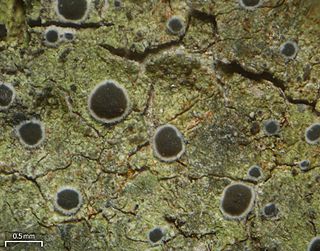
The Pilocarpaceae are a family of crustose lichens in the order Lecanorales. The species of this family have a cosmopolitan distribution and have been found in a variety of climatic regions. Pilocarpaceae was circumscribed by Alexander Zahlbruckner in Adolf Engler's influential 1905 work Die Natürlichen Pflanzenfamilien.

Bacidina is a genus of lichens in the family Ramalinaceae. It was circumscribed by Czech lichenologist Antonín Vězda in 1990, with Bacidina phacodes assigned as the type species. Vězda included 11 species in Bacidina, which was originally classified in the Lecideaceae. These species had previously been placed in genus Bacidia.
Aciculopsora is a genus of lichens in the family Ramalinaceae. It was circumscribed by lichenologists André Aptroot and Marie Trest in 2006.
Lueckingia is a genus in the family Ramalinaceae. It is a monotypic genus, containing the single corticolous lichen species Lueckingia polyspora. The genus and species were described as new to science in 2006. The species, known only from Costa Rica, was originally found growing on bark in the shaded understory of a lowland rainforest. The genus name honours German lichenologist Robert Lücking (b.1964), who organized the field trip that resulted in the discovery of the new species.

Porina is a genus of lichens in the family Trichotheliaceae. A 2020 estimate places about 145 species in the widespread genus.
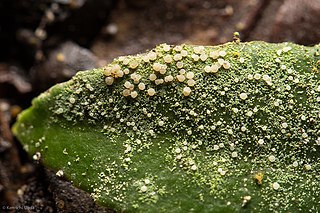
Fellhanera is a genus of mostly leaf-dwelling lichens in the family Pilocarpaceae. The genus, circumscribed by lichenologist Antonín Vězda in 1986, honours Austrian lichenologist Josef Hafellner.

Calopadia is a genus of foliicolous (leaf-dwelling) lichens in the family Pilocarpaceae. It was circumscribed by Czech lichenologist Antonín Vězda in 1986.
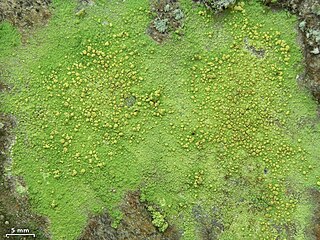
Psilolechia is a genus of four species of crustose lichens. It is the only member of Psilolechiaceae, a family that was created in 2014 to contain this genus.

Melanelia is a genus of lichenized fungi in the family Parmeliaceae. The genus was circumscribed by Ted Esslinger in 1978.

Flavoparmelia is a genus of foliose lichens in the family Parmeliaceae. Because of their appearance, they are commonly known as greenshield lichens. The widely distributed genus contains 32 species. It was circumscribed by American lichenologist Mason Hale in 1986 to contain 17 former Pseudoparmelia species with broad lobes, usnic acid in the cortex, and isolichenan in the cell walls.

Lecidella is a genus of crustose lichens in the family Lecanoraceae.

Protoparmelia is a genus of lichenized fungi in the family Parmeliaceae. The genus has a widespread distribution, and contains 11 species. Protoparmelia was circumscribed by French lichenologist Maurice Choisy in 1929.

Malmideaceae is a family of crustose and corticolous lichens in the order Lecanorales. It contains eight genera and about 70 species.

Kalbionora is a lichen genus in the family Malmideaceae containing the single crustose species Kalbionora palaeotropica. This lichen occurs in coastal forests in Thailand, Vietnam, and northeastern Australia, where it grows on tree bark.
Sprucidea is a genus of four crustose lichens in the family Malmideaceae. Similar to the related genus Malmidea, Sprucidea is characterized by frequently red thalli that contain the secondary compound norsolorinic acid, but differs in the rod-shaped instead of ellipsoid ascospores and in the stalked sporodochia as conidiomata. Sprucidea species are found in rainforest areas in South America and Southeast Asia.

Notoparmelia is a genus of foliose lichens in the family Parmeliaceae. It includes 18 species that grow on bark and rocks, and are mostly distributed in the Southern Hemisphere. The genus was created in 2014 as a segregate of Parmelia.
Austromelanelixia is a genus of five species of foliose lichens in the family Parmeliaceae. All species are found in the Southern Hemisphere.
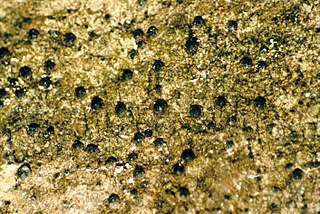
Scoliciosporum is a genus of lichens in the family Scoliciosporaceae.
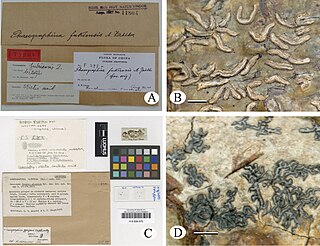
Graphidales is an order of lichen-forming fungi in the class Lecanoromycetes. It contains 6 families, about 81 genera and about 2,228 species. Family Graphidaceae are the largest crustose family within Graphidales order comprising more than 2000 species, which are widely distributed in tropical and subtropical regions of the world.














